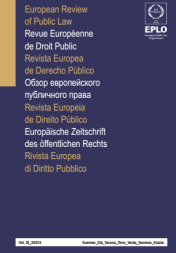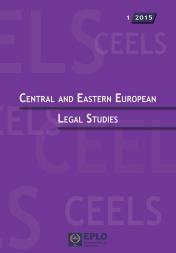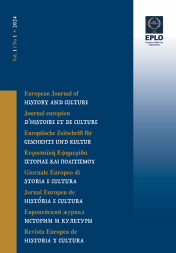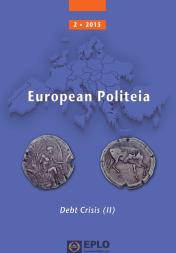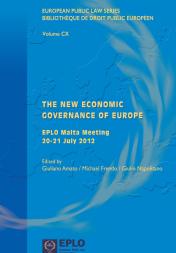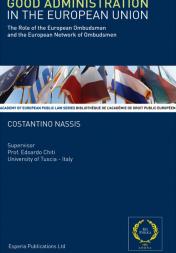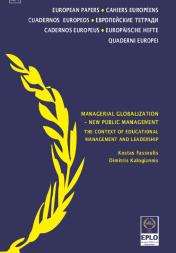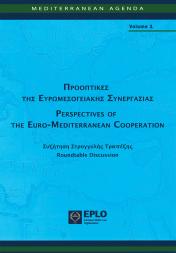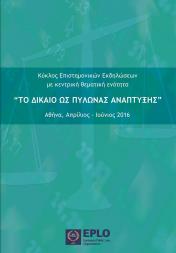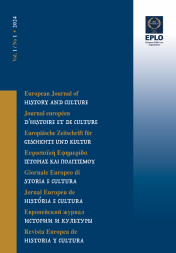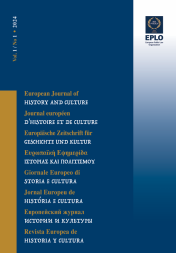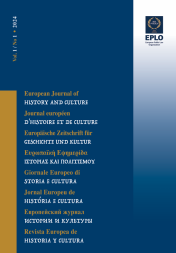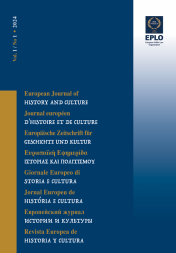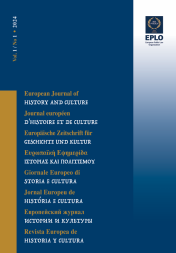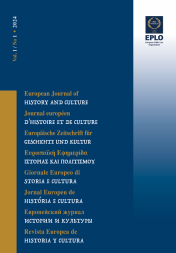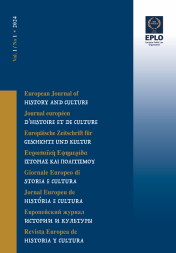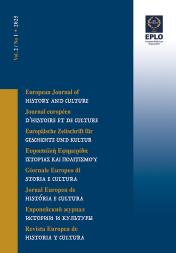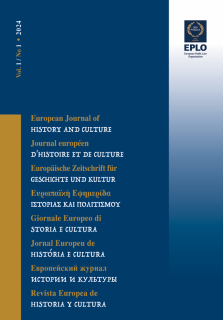
European Journal of History and Culture, Vol. 1 / No 1 • 2024
The first issue of the European Journal of History and Culture (Vol. 1 / No 1 • 2024) hosts 10 studies covering the period from antiquity to the 20th century. Through a scientific discussion and interdisciplinary exploration are analyzed themes in the fields of history, history of art, education and culture.
The issue starts with an article on the influence of recent ideological rivalries on the international system. Western values, which derive their origins from the Greco-Roman heritage and the Enlightenment, and have been contested and redefined since the Cold War era, provide the basis of the discussion. The scope of the article is to determine what kinds of alignments have emerged since the end of that period, how much they are related to cultural differences, and whether they are an obstacle to global cooperation.
The second article consists of three distinct and interconnected units, within which certain aspects concerning the study of Greek language and culture in contemporary Italy are analysed. The first part focuses on the ‘hemorrhage’ of enrolments in the Liceo Classico, which in 2024 registered 5.8% nationwide, a slight drop from the previous year’s 6.2%. The paper seeks to examine if we are really witnessing the sad demise of the Liceo Classico, or we are observing a phenomenon of change, kept poised between the past and the future after the reorganization of secondary schools with the reform of 2010. The second section focuses on the teaching of Modern Greek at the Ca’ Foscari University of Venice and on the prospects of teaching Neo-Greek in Italian schools. Finally, the last part, taking its cue from an exhibition held at the Braidense National Library in Milan, deals with the history of Greek learning in Italy from the mid-14th century until the Unification of Italy.
The following article offers a review of key historical events and philosophical shifts which defined the long process and shaped the development of modern East European nations. Αlso highlights the complex interplay between historical heritage and modern national identity. At the center of the study is placed the Byzantine Commonwealth, the “crucible”, wherein profound Christian theological inquiries flourished, thus laying the groundwork for an authentically ecumenical Orthodoxy. It emerges, also, the resilience of Byzantine culture that contributed significantly to the formation of modern Neo-Hellenic/Neo-Byzantine identities, influencing contemporary sociopolitical movements and policies.
The fourth article analyzes the academic discussion on the role of the state in the economy in the periphery of Europe at the turn of the twentieth century. Focuses on the thought of two outstanding academic economists, Ioannes Soutsos and Andreas Andreades, who founded the science of economics in Greece. Contrary to the calls of the Kathedersozialisten Soutsos and Andreades believed that the role of the state in the society and the economy should remain limited. Their aim was to define the optimal policy for the member states of the Latin Monetary Union, which included Greece and the other Balkan countries.
The next article deals with the library of lawyer Altavilla Calichiopulo (1673-1701), a Corfiot nobleman. His rich book collection was not a merely “professional library”, but gathered philological, theological, philosophical and legal books. The latter in particular offer a rare view on the legal tools of a practising attorney in the Venetian Stato da Mar, useful in defending cases in Corfu, where jurisdiction applied often incomplete and uncertain legal rules.
The following paper seeks to illuminate the tangible and intangible cultural heritage of women who lived in the Venetian colonies of the eastern Mediterranean in the first half of the 17th century, based on probate inventories detailing the material world in which they lived. It analyzes aspects of women’s history through the objects they used in their daily lives, with a specific focus on the case of Anezina, a cittadina (i.e., a woman belonging to the middling social stratum) in the Venetian city of Candia in Crete. The author illuminates hidden aspects of early modern European material culture and aims to de-marginalize women’s daily life in urban spaces of the eastern Mediterranean, offering a “different” narrative of the particular spacetime.
The seventh article deals with the history of the military family Branas (originated from Adrianople). The inscription of a seal of Theodoros Branas prompted us to trace the rise and subsequent fate of this military house especially between 1183 and 1204. At the center of the research is the way in which General Alexios Branas, called the καῖσαρ, the expedition leader of the Byzantine army against the Bulgarovlachs (1187) and his son, Theodoros, are depicted on seals.
The next article deals with the transition from the aesthetic of ancient Greek art to the Medieval aesthetic. The beginning can be traced during the Late Roman period. A new artistic language was adopted by the Christian art and acquired its Byzantine face in the Eastern part of the Roman Empire. The article aims to exames the two currents that marked the Byzantine art, the Macedonian (10th-11th centuries) and Paleologian (13th-14th centuries) renaissance and the common language of the Comnene age (12th century), known as “koine”.
The ninth paper explores the ‘ism’-concepts in classical Greek texts by contrasting and comparing their ancient and modern uses. Isms are approached as temporalised concepts which appear either as characterising typologies or action-agential concepts. In the first section of the article are explored the formation and morphology of -ismόs words and their manifestations in ancient Greek classical texts. Via examples from the Greek terminology in the second section is analyzed the significant semantic shifting between classical antiquity and their later use. The third parte deals with the uses of isms in the study of ancient Greek religions.
Last but not least, the final article analyzes the meaning of term “justice” as presented by Aeschylus in the tragedy Oresteia. The justice as a restoration of the balance of an order that has been disturbed, and the restoration must be effected in a manner equivalent to the act that upset the former order; a kind of retribution. In a society in which people are starting to demand “isonomy” and “isegory” in the polis. When Democracy and law do not suppress or manipulate the passions, but include and “socialise” them; they make them civilised in the sense that they integrate them into a real dialogue about law and justice in the polis.
Summary
C. A. Stephanou, Cultural Divides and Geopolitical Alignments: How History Interacts with Modernity [IN ENGLISH] (24 pp.)
C. Carpinato, Future Greek: Italian Testimony at the Beginning of the 3rd Millenium AD [IN ITALIAN] (24 pp.)
S. Liantis / G. Kalpadakis, Hellenism in Captivity and “Neo-Hellenic” Nations: The Resilience of the Byzantine Identity after the Fall of Constantinople [IN ENGLISH] (31 pp.)
S. G. Ploumidis, Political Economy in Greece at the Turn of the Twentieth Century: The Views of Ioannes Soutsos and Andreas Andreades on the Functions of the State [IN ENGLISH] (22 pp.)
P. Tzivara / S. Gasparini, The Library of a Corfiot Lawyer, Altavilla Calichiopulo (1673-1701) [IN ITALIAN] (38 pp.)
T. Markaki, Objects and their Stories in Early Modern Europe: Anezina’s Tangible and Intangible Heritage (1647) [IN ENGLISH] (30 pp.)
A.-K. Wassiliou-Seibt, Power and Weakness of the Byzantine Aristocracy on the Eve of the Latin Conquest of Constantinople (1204). The Fate of the Branas Family [IN GERMAN] (35 pp.)
N. Panselinou, The Transition from the Aesthetic of Ancient Greek Art to the Medieval Aesthetic - Continuities and Discontinuities [IN ENGLISH] (11 pp.)
P. Pakkanen, Concepts Related to ‘isms’ in Ancient Greece and (Modern) ‘ismicism’ [IN ENGLISH] (27 pp.)
K. A. Papageorgiou, The Justice of the Oresteia. From Retributive Passion to Public Moderation [IN ENGLISH] (23 pp.)




